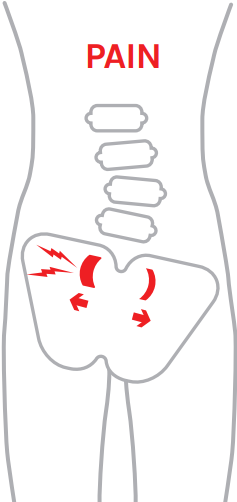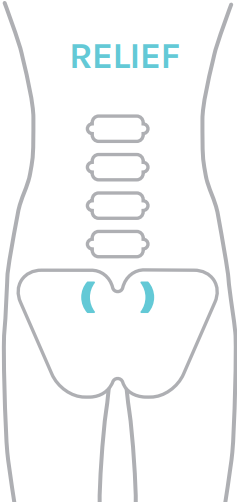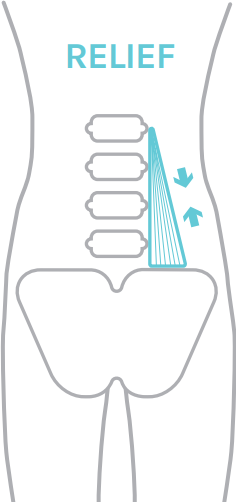
The International Association for the Study of Pain defines pain as “an unpleasant sensory and emotional experience associated with actual or potential tissue damage.” Those that have suffered pain know all too well the emotional impact it can have. Very often the mind and body are thought of as separate entities. In this article I want to introduce some of the latest concepts in neuroscience and cellular biology, regarding how your brain and body relate to each other, so you can understand that the management of lower back pain is as much an inner game as it is an outer game.
Control of your outer world is difficult to say the least; controlling thoughts and feelings in your inner world is not much easier. Before you dip into a state of abject powerlessness, please know that whilst controlling thoughts in your mind is not always easy, it is something that’s within our capabilities.
Our brain’s main purpose is to keep us alive. In an evolutionary context this conjures up visions of cave men running away from sabre-toothed tigers. There is a step that precedes performing everyday tasks or becoming lunch for that matter. Regulating your body to ultimately deliver nutrients, fluid and oxygen to your cells is the primary function of the brain; everything else is secondary to this. I know: BORRRRRRRING! A little less box office than running away from a T-Rex but a tad more vital.
Our brain does this through an ever-flowing stream of predictions, every second of every day until the day you draw your last breath. It’s a process called allostasis. Allostasis is like homeostasis, which is balancing the body’s functions to an optimum. However, allostasis is more about balancing the body’s functions in the next 5 seconds, 5 minutes, 5 hours. Your brain is constantly weighing up incoming data to make predictions, in order to simply stay alive. For example, before you get the impulse to stand, your brain has predicted your desire to stand and preempts this by elevating your blood pressure in preparation for you to move from a lower seated position to an elevated standing position.
Your brain interprets the sensory data, making sense of our outer world (exteroception) and inner world (interoception). We then turn these impulses into chemistry; hormones, peptides, neurotransmitters etc. A function of these chemicals is to communicate to our cells to make any adjustments necessary, in response to the ever-changing outer and inner environment.
In essence , our bodies are chemical factories. A really cool fact is that the function of pharmaceutical drugs is to cause the body to increase or decrease the production of chemicals that it already produces. You are the pharmacy. The drug determines how much of something you produce. To understand the vast number of pharmaceuticals available, have a search on Google for “BNF” (British National Formulary) and see how thick that book is. Licensed drugs act upon a mere fraction of what the body produces.

Even narcotic drugs like cocaine and amphetamines simply encourage the brain to produce more dopamine, which is already naturally and constantly made and released by the brain. Whether the drug is legal or illegal, the fact is that it’s the body coming up with the goods, not the likes of AstraZeneca nor Pablo Escabar.
When feeling stressed your body produces approximately 1,100 different chemicals, not just cortisol (which we all know about). When feeling positive there are approximately 1,200 chemicals being pumped out by the body and brain. This produces a cocktail of chemicals that bathe the cells of your body. These chemicals are communication to your cells. Sent with love from your allostatic brain. This communication informs the DNA within your cells, which genes need to be read, known as upregulation, in order to produce what is required by the body. Genes produce proteins, and proteins are the building blocks of life. Proteins repair injured muscle, tendons, ligaments etc.
An injury heals less effectively in stressful situations, something that has been proven over and over again -to a point where it is not just scientifically proven but clinically relevant. As a clinician, if I hear the words “clinically relevant” IT IS TIME TO GET BUSY!
The way I got busy was by developing Pelvipro. My aim was to enable a lower back pain sufferer to self-manage their pain independently at home, not only reducing their pain but creating a feeling of control. Pelvic motion dysfunction (AKA pelvic misalignment or PMD) is very common. In our clinic we have found PMD is present, to some degree, with nearly all lower back pain patients.
The pelvis is essentially balanced on top of your thigh bones. What happens in PMD is that the pelvis is pulled too far forward on one side due to poor muscular co-ordination. The pelvis is the central part of the body as well as the base of the spine, meaning this pulls your entire body off to one side. I have observed in my patients as much as a 3cm deviation.

When you think about any other physical structure, for example a table in a pub, if the leg is as much as 3mm off, then you know about it. Folded-up beer mat to the rescue! Unfortunately, your body is not like an inert wooden table leg. The tissue in your lower back contains nociceptive nerve tissue, which transmits pain when agitated. This excessive pull from the pelvis is enough to aggravate that nociceptive tissue, found in ligaments and muscles. In an instant, Pelvipro stops this from happening. A lot of the time this is why you get instant relief from pain.
By far the best outcome that comes from using Pelvipro is that feeling of control. Bear in mind the predictive nature of the brain and ensuing wave of chemicals. When you feel that oh-too-familiar pull in your lower back, in the past you would have to wait until the next time you see your chiropractor, osteopath or physio for some relief. This could be weeks away. With Pelvipro, it’s only a walk to your bedside table away.
Your predictive brain, when it feels that strain in your lower back, is no longer forewarning a long bout of crippling pain, incapacity and distress, played out like a movie in your mind. Instead, your mind is now imagining going for that lovely walk in the hills or taking that cherished trip to see the grandkids, once you’ve grabbed your Pelvipro to deal with this current back strain. That feeling of control is what our patients and now our online customers report back to us ALL OF THE TIME.
To experience the physical and emotional benefit from Pelvipro please go to: Pelvipro Device + The Back Fit Tool Kit
If you want to learn a little bit more about how emotions interact with the body, I would highly recommend How Emotions are Made: The Secret Life of the Brain and Seven and a Half Lessons About the Brains, both written by Dr Lisa Feldman Barratt; You are the Placebo by Dr Joe Despenza; and The Biology of Belief by Dr Bruce Lipton.















